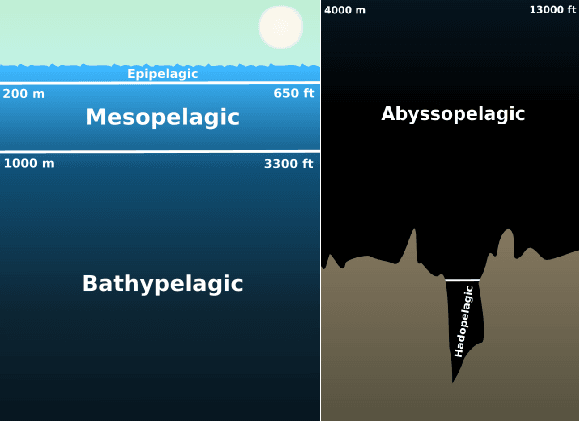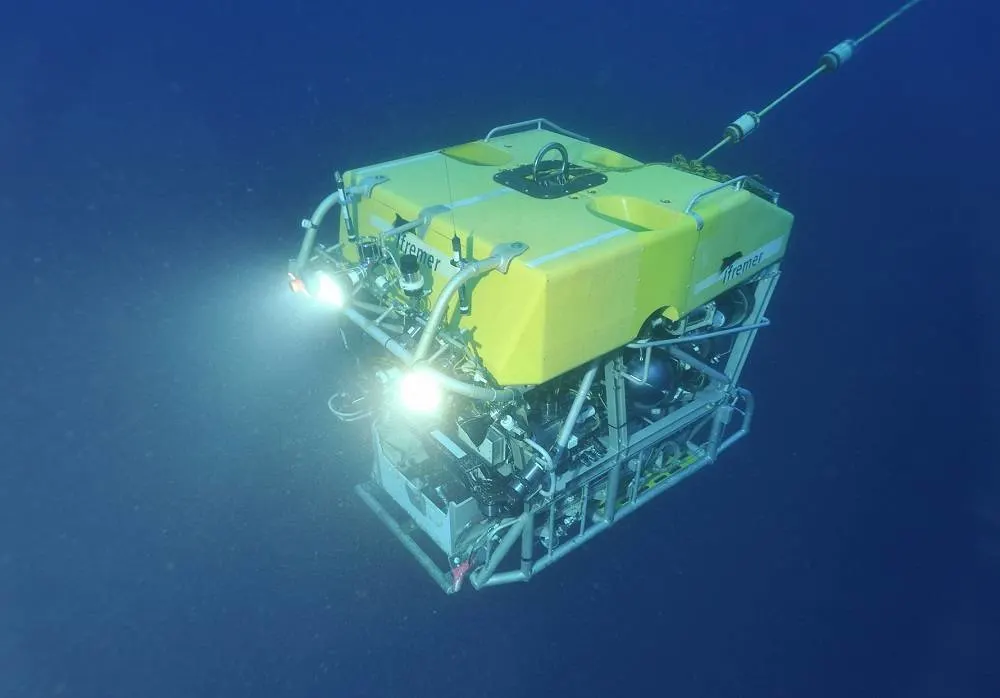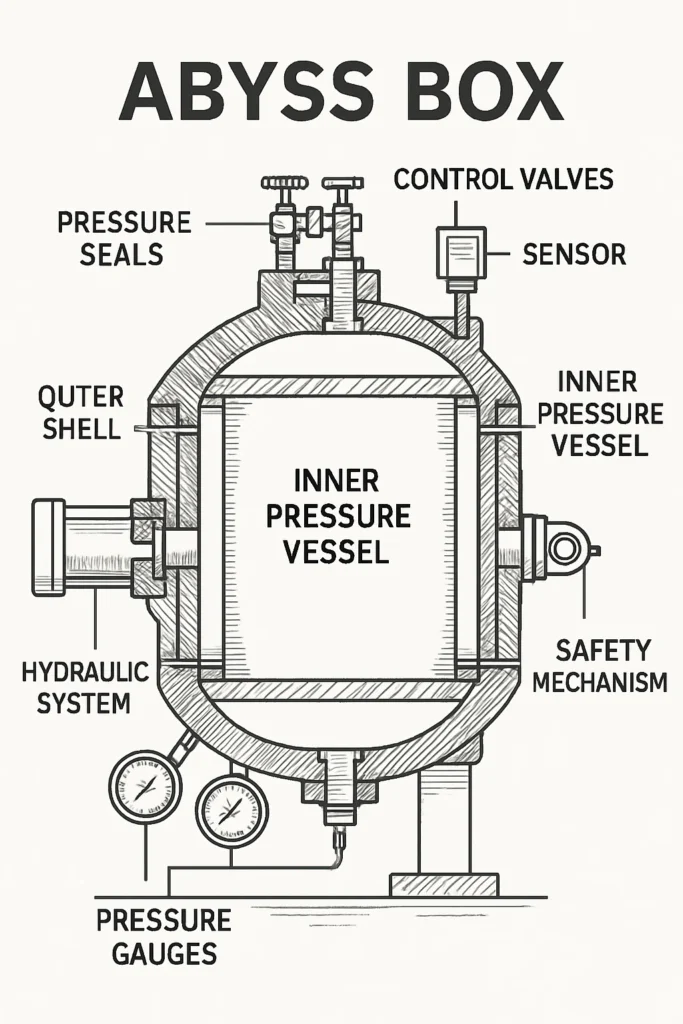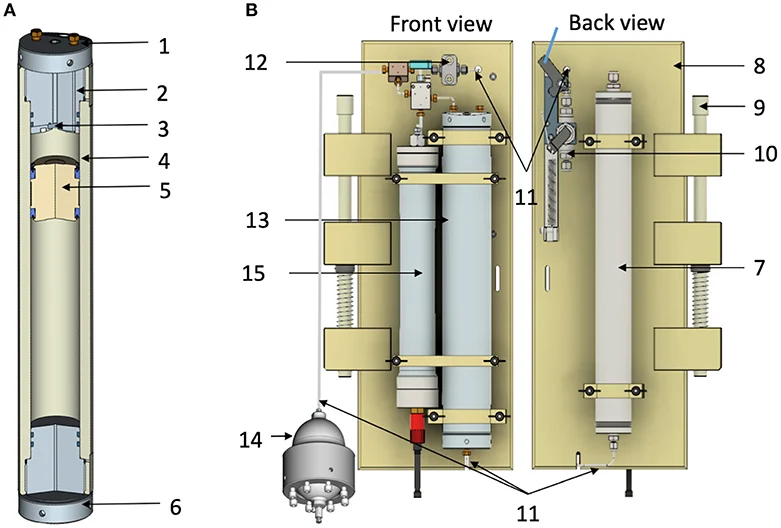Introduction

The deep ocean is the largest and most mysterious biome on Earth. It is a realm of eternal darkness, frigid temperatures, and immense, soul-crushing pressure that defies human exploration and comprehension. To make this extreme environment tangible, consider this: at a depth of 2,500 meters, the pressure is equivalent to 250 atmospheres, a force that biophysicist Dr. Bruce Shillito compares to “an elephant sitting on your toenail”. This colossal weight of water shapes every aspect of life, forging organisms with unique physiologies that are exquisitely adapted to their abyssal homes.
For centuries, this world remained hidden, accessible only through the mangled remains of creatures hauled to the surface in nets. This created a fundamental paradox for marine biology: the very act of retrieving a deep-sea specimen for study was what killed it. The rapid, uncontrolled ascent from the depths causes catastrophic decompression damage, rupturing gas-filled swim bladders and fatally disrupting cellular structures. Scientists were left to study ghosts, attempting to understand the living from the dead.
This is the challenge that gave rise to the Abyss Box, an elegant and revolutionary solution to the decompression paradox. It is far more than a simple tank; it is a meticulously engineered high-pressure marine habitat, a portable piece of the abyss brought to land. Functioning as both a cutting-edge deep ocean research tool and a unique public exhibition, the Abyss Box acts as a portal, a window into an alien world that allows us to not only peer in but to bring its inhabitants into our world, alive and unharmed.

The development of such a device represents a triumph over immense technological and conceptual hurdles. The deep sea is one of the last true frontiers on our planet, and the challenge has always been twofold. First is the technological barrier of building a vessel strong enough to contain the immense pressures of the deep. Second is the conceptual barrier of how to study a living system that we cannot enter and that cannot leave its native environment. By making the unseen visible and the abstract tangible, the Abyss Box transcends its role as a mere piece of hardware. It becomes a psychological bridge, overcoming the “out of sight, out of mind” problem that has long hindered deep-sea research and conservation. For the first time, the public can witness the “beauty and fragility of deep-sea life” firsthand, fostering a connection that is vital for inspiring the scientific curiosity and political will needed to protect this vast, hidden realm.
The Genesis of the Abyss Box: An Evolutionary Leap in Marine Technology
The Abyss Box was not a spontaneous invention but the culmination of years of focused research and iterative innovation. Its creation was spearheaded by a visionary team of French scientists, demonstrating a powerful synergy between pure research, applied engineering, and public outreach.
The Visionary and His Collaborators
The driving force behind this technological leap was French researcher Dr. Bruce Shillito from the Pierre and Marie Curie University in Paris (now Sorbonne Université). The project, which was officially initiated in late 2009 following a deep-sea conference in Japan, was a deeply collaborative effort. It brought together the expertise of France’s premier scientific institutions, including the CNRS (French National Centre for Scientific Research) and IFREMER (French Research Institute for Exploitation of the Sea). A crucial and defining element of the project was the partnership with the Océanopolis aquarium in Brest, France, which provided the public-facing platform for this world-first exhibition.
This collaboration reveals a foundational philosophy that guided the project from its inception. The goal was never simply to build a better laboratory instrument; it was to forge a direct conduit between the frontiers of scientific discovery and the public consciousness. The project’s stated aims were to “serve both scientific and public interests” and to “draw the public’s attention towards the deep ocean”. By embedding this technology within a public aquarium, the creators demonstrated a sophisticated understanding that public engagement is a powerful engine for scientific progress. The awe inspired by watching a living creature from the abyss fuels the curiosity, funding, and political support necessary for further exploration and conservation. The Abyss Box, therefore, is as much a tool for scientific advocacy as it is for biological research.
Standing on the Shoulders of Giants: A Technological Lineage
The Abyss Box stands as the pinnacle of a clear, step-by-step technological evolution, with each preceding invention solving a critical piece of the puzzle. This iterative process shows how major breakthroughs are often the result of persistent, incremental engineering rather than a single “eureka” moment.
PERISCOP (Projet d’Enceinte de Remontée Isobare Servant la Capture d’Organismes Profonds): Developed by Shillito and his team, this device was the first critical step. It solved the problem of retrieval. The PERISCOP is a pressurized recovery device that allows for isobaric sampling—capturing an animal at depth and bringing it to the surface while maintaining its native pressure. It famously set a record by retrieving a live fish from a hydrothermal vent at a depth of 2,300 meters, but it was primarily a transport vessel, not a long-term habitat.

IPOCAMP (Incubateur Pressurisé pour l’Observation et la Culture d’Animaux Marins Profonds): The IPOCAMP was the next logical step. It was a pressurized laboratory incubator designed for short-term observation and experimentation on live deep-sea organisms. It provided a controlled environment for scientific study but was not engineered for the rigors of permanent, long-term maintenance or public display.
The Abyss Box: This device represents the synthesis and culmination of all the lessons learned from its predecessors. The Abyss Box was directly inspired by the IPOCAMP design but was engineered for a far more ambitious purpose: permanent, long-term maintenance and public exhibition. It integrated the retrieval principles pioneered with PERISCOP and the experimental capabilities of IPOCAMP into a single, robust, and self-sustaining system designed to operate flawlessly for years in a public setting.
This clear technological lineage from retrieval (PERISCOP) to short-term study (IPOCAMP) to long-term exhibition (Abyss Box) highlights a methodical and strategic approach to solving one of the greatest challenges in marine biology.
Engineering the Abyss: The Anatomy of a High-Pressure Habitat
To create a stable, livable piece of the deep ocean on land is an engineering challenge of staggering proportions. The most striking illustration of this is the Abyss Box’s sheer mass: all the equipment required to maintain the environment within its tiny 16.5-liter chamber weighs a colossal 600 kilograms (1,300 pounds). This incredible ratio of mass to volume underscores the extreme forces at play and the robust engineering required to contain them. The true innovation is not found in any single component, but in the seamless and holistic integration of multiple, interdependent life-support systems. It is less like building a simple pressure vessel and more like designing a miniature, high-pressure International Space Station for marine life.
The Pressure Vessel: A Fortress of Steel and Crystal
At the heart of the system is the pressure vessel itself, a fortress built to withstand the abyss.

Construction: The chamber is forged from two main parts of 316 Ti stainless steel, a titanium-stabilized grade known for its exceptional strength and corrosion resistance. These two halves are assembled with 16 heavy-duty screws and sealed with a high-performance O-ring, a deceptively simple component that is critical for maintaining the pressure seal.
Pressure Ratings: The Abyss Box is designed to operate routinely at pressures up to 20 megapascals (MPa), or 200 times atmospheric pressure, which simulates an ocean depth of approximately 2,000 meters. To ensure safety, it was tested to a pressure of 38 MPa, nearly double its operational limit, demonstrating the significant safety margins engineered into its design.
The Viewports: Creating a window into this high-pressure world is one of the greatest engineering feats of the device. The main public-facing viewport is a conical piece of transparent quartz or acrylic, 8 to 10 cm thick. This small window, only about 15 cm in diameter, must withstand a total force greater than the weight of a jumbo jet. In addition to the main portal, four smaller conical viewports, each with a 1 cm optical diameter, are positioned at a 45-degree angle to allow for illumination of the chamber’s interior using fiber-optic light guides, enabling clear observation without compromising the vessel’s integrity.
The Life Support System: A Symphony of Pumps and Sensors
Maintaining a stable environment inside the Abyss Box requires a dynamic and precisely controlled life support system.
Pressurization and Circulation: The system operates on a “flow-through” principle. Seawater is first filtered and then fed to a high-pressure pump, which pressurizes it to the target level. This water circulates through the tank at a rate of up to 10 liters per hour. The key to control lies in a manually operated back-pressure valve on the outlet line. By carefully adjusting this valve, scientists can set and maintain the exact pressure inside the chamber, while the constant flow ensures that animal wastes are flushed out and water quality remains pristine.
Temperature Control: Replicating the complex thermal environment of a hydrothermal vent requires a sophisticated dual-temperature system. A primary cooling/heating unit circulates fluid around the main vessel to maintain a stable, cold background temperature (e.g., 10°C). Crucially, a second, smaller regulator circulates a warmer fluid (e.g., 27°C) through a ring-shaped tube located inside the aquarium. This creates a localized “hotspot,” mimicking the thermal gradients that vent creatures experience in their natural habitat and allowing them to thermoregulate by moving closer to or farther from the heat source.
Oxygenation and Filtration: The constant flow-through of fresh, aerated seawater is sufficient to maintain stable and appropriate oxygen levels for the inhabitants. On the outlet, a fine 1 micrometer (µm) mesh filter collects animal waste before the water reaches the back-pressure valve, preventing the system from clogging.
The Isobaric Feeding Mechanism: An Airlock for the Abyss
One of the most ingenious aspects of the Abyss Box is its solution to a seemingly simple problem: how to feed the animals without depressurizing the entire system. The answer is an isobaric feeding line, which functions much like an airlock on a space station. This separate, 1 cm diameter tube located above the main vessel can be isolated and depressurized. Food, such as pieces of blue mussel, is placed inside at normal atmospheric pressure. The line is then sealed and re-pressurized to match the tank’s internal pressure. A valve is opened, and the food simply sinks down to the inhabitants, all without causing any pressure change in their environment. This clever mechanism is essential for the long-term husbandry that makes the Abyss Box so revolutionary.
Table 1: Abyss Box Technical Specifications
| Parameter | Specification |
|---|---|
| Internal Volume | 16.5 Liters (4.2 US gal) |
| Operating Pressure | 18 – 20 MPa (180 – 200 bar) |
| Max Depth Simulation | ~1,800 – 2,000 meters |
| Total Weight | 600 kg (1,300 lbs) |
| Construction Material | 316 Ti Stainless Steel |
| Main Viewport Thickness | 8 – 10 cm |
| Main Viewport Diameter | 15 cm (outside diameter) |
| Water Flow Rate | Up to 10 L/hour |
| Temperature Range | 2°C to 40°C |

The Scientific Revolution: Discoveries from a Pressurized World
The Abyss Box and its predecessors have done more than just keep deep-sea creatures alive; they have fundamentally transformed how scientists study them. By enabling long-term in vivo experiments on healthy, acclimated animals, this technology has opened the door to a new era of discovery, moving marine biology from the study of dead specimens to the dynamic investigation of living physiology and behavior.
Keeping Deep-Sea Creatures Alive: A New Era for Marine Biology
The most foundational breakthrough has been the unprecedented success in long-term husbandry. For the first time, scientists have been able to maintain and observe deep-sea animals for years. The inhabitants of the Abyss Box, primarily the hydrothermal vent shrimp Mirocaris fortunata and the vent crab Segonzacia mesatlantica, were collected from the Lucky Strike vent field on the Mid-Atlantic Ridge at depths of around 1,700 meters, using the remotely operated vehicle (ROV) Victor 6000.

Inside their pressurized home at the Océanopolis aquarium, these animals have thrived. Some of the crabs have been kept for over two years, and some shrimp have survived for more than three years in captivity. This remarkable achievement has provided the first-ever reliable data on the natural lifespans of these species, a basic biological parameter that was previously a complete mystery. This ability to observe organisms over long periods is the bedrock upon which all other physiological and behavioral studies are built.
Unraveling the Secrets of Adaptation
Once the technological hurdle of long-term survival was overcome, it opened the floodgates to more sophisticated biological questions, allowing research to progress from whole-organism observation to the cellular and molecular level. The Abyss Box became a platform for integrative biology.

Piezophysiology (Pressure Biology): The ability to maintain animals under controlled pressure has enabled fundamental research into how they cope with their extreme environment. Studies using the IPOCAMP and Abyss Box have investigated the expression of heat-shock proteins (HSP70) and other molecular stress responses, revealing the biochemical machinery that protects these animals from thermal and pressure-related damage.
Homeoviscous Adaptation: Groundbreaking research has explored how animals like Mirocaris fortunata actively modulate the lipid composition of their cell membranes to maintain proper fluidity and function under crushing pressure. This process, known as homeoviscous adaptation, is a critical survival mechanism, and studying it in live, acclimated animals has provided unparalleled insights into its dynamics.
Thermal Biology: The precise temperature controls of the Abyss Box, including its “hotspot” feature, have allowed scientists to conduct experiments to determine the exact upper thermal limits of vent species. For example, experiments showed that shrimp from the Menez Gwen and Lucky Strike vent fields have a critical thermal maximum of around 36°C. This kind of data is crucial for understanding their ecological niches and how they partition their habitat around the steep temperature gradients of hydrothermal vents.
A Laboratory for a Changing Planet
Perhaps one of the most critical applications of the Abyss Box is its role as a laboratory for studying the effects of climate change on the deep ocean. The deep sea is not immune to the impacts of a warming world. By precisely controlling the temperature, pH, and other parameters inside the tank, scientists can simulate future ocean conditions and observe how deep-sea species respond to the dual threats of ocean warming and acidification.
This research is vital for predicting the future of deep-sea ecosystems. It helps scientists determine which species might possess the physiological flexibility to migrate to deeper, cooler waters to escape warming surface layers, and which species may be effectively trapped and face extinction. This reframes the deep sea from a static, isolated realm into a dynamic and vulnerable ecosystem that is both affected by and can inform our understanding of global climate change. The Abyss Box is the critical tool that makes this forward-looking research possible, turning these tiny, resilient creatures into bellwethers for the health of our planet.
The Next Frontier: Future Applications and Evolution
The Abyss Box, while revolutionary, is a prototype—a first step into a larger world of high-pressure bioscience. The technology it pioneered is poised to evolve and find applications in fields far beyond oceanography, converging with disciplines as diverse as medicine, manufacturing, and even the search for life beyond Earth.
The Evolution of Pressure Chambers
The future of the technology will likely involve scaling up. Researchers hope to eventually build larger versions of the Abyss Box capable of housing bigger and more complex animals, such as deep-sea fish, which would open up entirely new avenues of research. This evolution will be influenced by advancements in the broader market for hyperbaric and saturation diving chambers, which is driving innovation in automation, remote monitoring, integrated life support, and the development of lighter, stronger, and more advanced materials. Future scientific pressure aquariums will almost certainly be more modular, more automated, and capable of simulating even greater depths with higher fidelity.
From the Deep Ocean to Deep Space: An Astrobiological Analog
The extreme environments of deep-sea hydrothermal vents—characterized by high pressure, total darkness, and unique geochemistry—are considered one of Earth’s best space analog environments. They provide a compelling model for what life might look like on the ocean worlds of our solar system, such as Jupiter’s moon Europa or Saturn’s moon Enceladus.
The technological challenges overcome in the design and operation of the Abyss Box are directly relevant to the challenges of designing probes and landers for astrobiological missions. The core problems—pressure containment, closed-loop life support, remote operation, and robotic sampling—are fundamentally the same. This synergy is not theoretical; NASA’s SUBSEA (Systematic Underwater Biogeochemical Science and Exploration Analog) program explicitly uses deep-sea exploration as a training ground to practice and refine the operational strategies for future human-robotic missions to the Moon and Mars. This demonstrates a clear convergence of extreme environment technologies, where a breakthrough in materials science for a deep-sea submersible could directly benefit the design of a probe destined for Europa. The Abyss Box stands as a tangible, early example of this powerful technological crossover.
The Abyss as a Pharmacy: Bioprospecting and Biotechnology
The ability to study live deep-sea organisms is not merely an academic pursuit; it unlocks a new frontier of economic and medical innovation. Extremophiles—organisms that thrive in conditions lethal to most life—are a biological treasure trove of unique enzymes, proteins, and biochemical compounds that have evolved to function under incredible stress. The primary barrier to harnessing this potential has always been the difficulty of accessing and cultivating these organisms.
Pressurized aquariums like the Abyss Box directly address this barrier, making them critical enablers for bioprospecting and the burgeoning field of “blue biotechnology.”
Industrial Applications: The unique, pressure-stable enzymes found in these organisms could revolutionize industrial processes. High-Pressure Processing (HPP) is already a major trend in the food industry for non-thermal pasteurization, and novel enzymes could make these processes even more efficient.
Pharmaceuticals and Medicine: The deep sea is a largely untapped source of novel pharmaceutical compounds. Sessile invertebrates, in particular, produce potent chemicals for defense that have shown anti-cancer, anti-inflammatory, and antibiotic properties. Furthermore, high-pressure bioscience itself is an emerging field with potential applications in creating new vaccines, sterilizing fragile biopharmaceuticals without heat or radiation, and even reversing the aggregation of misfolded proteins, which is relevant to neurodegenerative diseases.
By providing sustained access to the living chemistry of the abyss, the Abyss Box and its successors may well become the key that unlocks a new generation of medicines and biotechnologies.
Conclusion: The Enduring Importance of Exploring the Deep
The Abyss Box is far more than a heavy-duty fish tank. It stands as a powerful symbol of human ingenuity and a pivotal tool that has fundamentally reshaped our ability to study the largest and least-understood habitat on our planet. It is a bridge connecting the frontiers of ocean science with public awareness, a critical instrument for understanding the impacts of climate change, and a technological stepping stone on the path to exploring other worlds.
The deep sea, which comprises over 75% of the ocean’s total volume, is not a remote and disconnected wasteland; it is a vital component of the global system, playing an irreplaceable role in regulating climate and driving global carbon and nutrient cycles. The health of the abyss is inextricably linked to the health of the entire planet.
For these reasons, exploring and understanding this last great frontier is not a scientific luxury but a global necessity. The journey of the Abyss Box—from an ambitious idea to a working portal to the deep—illustrates the power of sustained, collaborative, and innovative research. Continued investment and support for the development of these and next-generation deep-sea technologies are essential. By pushing the boundaries of what is possible, we not only expand our own knowledge but also enhance our capacity for responsible planetary stewardship, ensuring that the mysteries of the deep continue to inspire and inform generations to come.
Reference: All images and content are taken from Essentials of Oceanography by Alan P. Trujillo and Harold V. Thurman, 12th Edition.
